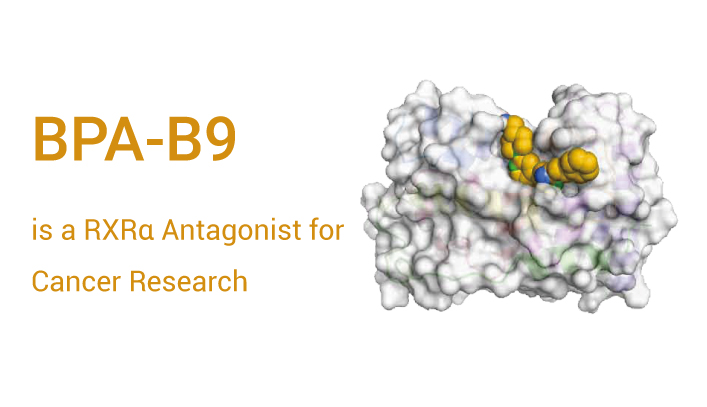Retinoid X receptor alpha (RXR-alpha), also known as NR2B1, is a member of the retinoid x receptor (rxr) family, which is a group of transcription factors that regulate gene expression. Specifically, RXR-alpha forms heterodimers with other nuclear receptors, such as thyroid hormone receptors, vitamin D receptors, and peroxisome proliferator-activated receptors, to modulate transcriptional activity. RXR-alpha is widely expressed in many tissues, including the liver, lung, kidney, and brain. It plays a critical role in the regulation of development, differentiation, and homeostasis. Dysregulation of RXR-alpha has played a role in numerous diseases, including cancer, diabetes, and metabolic disorders.
BPA-B9 is an RXRα antagonist for cancer research.

BPA-B9 is an RXRα ligand and antagonist targeting the pRXRα-PLK1 interaction. Moreover, it has excellent RXRα-binding affinity (KD=39.29 ± 1.12 nM). BPA-B9 inhibits the proliferation of cancer cells by inducing mitotic arrest and cell apoptosis. In some in vitro studies, BPA-B9 (0-250 nM, 24 h) can induce apoptosis. Secondly, it induces a dose- and time-dependent increase in the expression of cleaved PARP in MDA-MB-231 cells, anti-apoptotic proteins Bcl-2 and Mcl-1 dose Dependency reduction. Besides, BPA-B9 inhibits the cell cycle of A549 in the G2/M phase. After incubation with BPA-B9 at 62.50 nM and 125 nM, the percentage of A549 cells in the G2/M phase reached 12.89% and 46.49%, respectively, compared to 8.62% in untreated cells.
In addition, BPA-B9 (0-25 mg/kg, intraperitoneal injection, once a day, for 15 consecutive days) has a significant anti-cancer effect in BALB/c mice with no obvious side effects. Importantly, it inhibits tumor growth by causing mitotic arrest, chromosome aberrations, and DNA damage response. Significantly reduced the tumor volume and the tumor growth inhibition (TGI) of BPA-B9 was 59.3% at a dosage of 25.0 mg/kg/day, but a slight difference was shown at the dose of 12.5 mg/kg/day with no statistical significance.
In conclusion, BPA-B9 is an RXRα ligand and antagonist targeting the pRXRα-PLK1 interaction for cancer research.
References:
[1] Jun Chen, et al. Eur J Med Chem. 2023 Apr 6;254:115341.
[2] Vanessa Núñez, et al. Proc Natl Acad Sci U S A. 2010 Jun 8;107(23):10626-31.